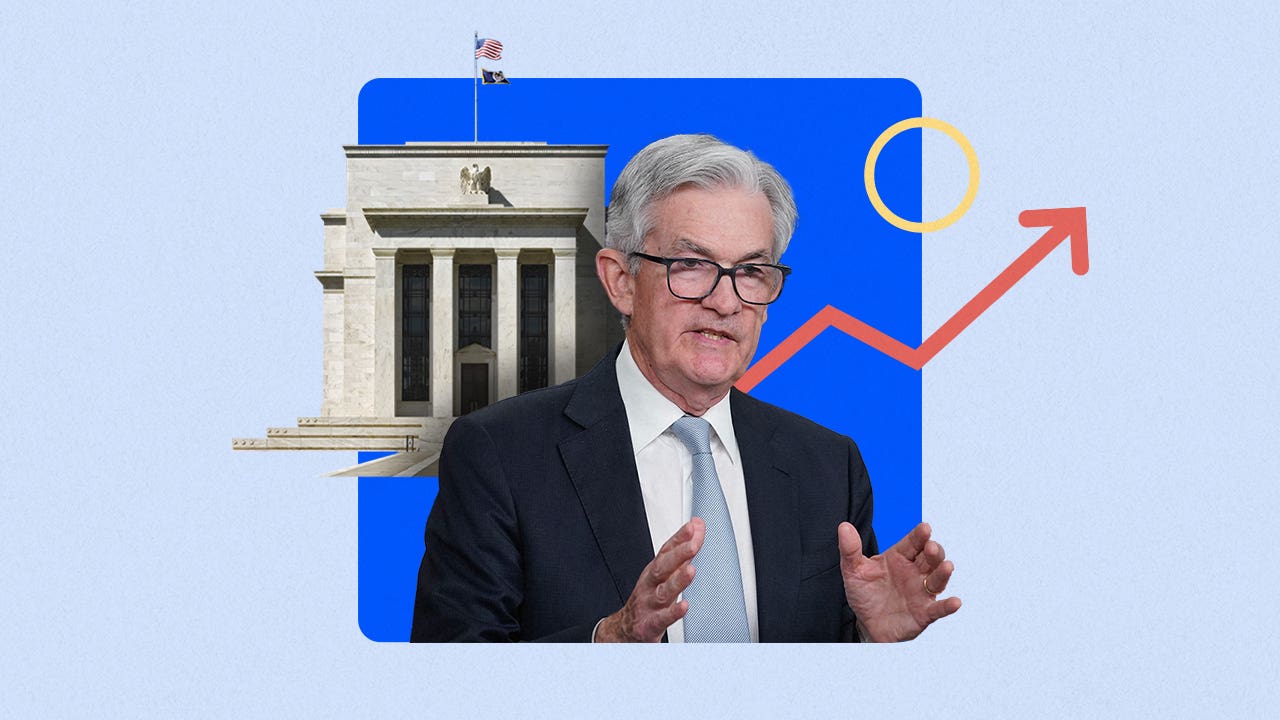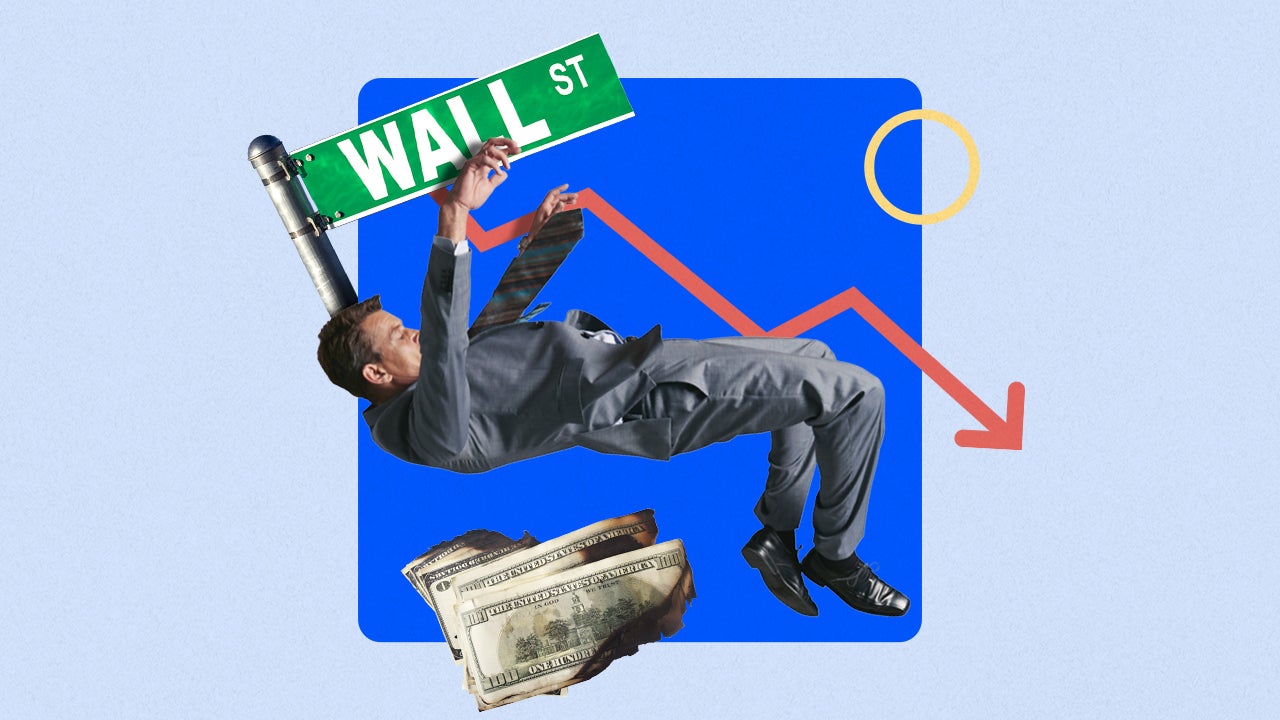Survey: Economists predict Fed will lift rates to highest since 2001

The Federal Reserve surprised investors and consumers when it suggested that it’s penciling in two more rate hikes this year — moves that would take interest rates to a level not seen since 2001.
Economists were at first skeptical that the Fed will be able to follow through. They now, however, may be starting to take the Fed at its word.
The average forecast for the Fed’s peak benchmark interest rate — also referred to as the “terminal” rate — is projected to be 5.6 percent, economists told Bankrate in its latest quarterly Economic Indicator survey. That forecast implies that rates will hit a new target range of 5.5-5.75 percent, exactly in line with Fed officials’ projections from their fresh rate estimates updated in June. It’s also now higher than economists’ estimates from the prior-quarter survey, when experts penciled in a 5-5.25 percent federal funds rate.
Few economists (6 percent) also say the Fed could begin cutting interest rates in 2023. Most (78 percent) say the Fed won’t begin cutting rates until 2024 — also in line with the Fed’s own estimates. Yet, 17 percent say the Fed may not begin cutting rates until 2025 or later amid risks that inflation could be more entrenched and stubborn than originally expected. Those totals exceed 100 percent due to rounding.
How high the Fed takes interest rates has major implications for borrowing costs and Americans’ wealth-building opportunities. Investors may have to brace for a bumpy ride as market participants embrace the reality of higher rates for longer, while more rate hikes could translate to a slower — if not tougher — job market.
Economists fear that one likely cost of the Federal Reserve’s interest rate raising campaign will be rising unemployment and subpar hiring over the next year. At the same time, the job market has proven more resilient than many would have expected.— Mark Hamrick, Bankrate senior economic analyst
Key interest rate insights from Bankrate’s Economic Indicator survey
- Economists, on average, see the Federal Reserve lifting interest rates to 5.5-5.75 percent peak target range, the highest level since 2001 and in line with the Fed’s own projections.
- That forecast suggests two more rate hikes worth 25 basis points are on the table, meaning the Fed’s post-pandemic inflation fight will amount to 12 total increases.
- The majority (78 percent) of economists say the Fed probably won’t begin cutting rates until 2024.
- Economists see the 10-year Treasury yield — a benchmark for the 30-year fixed-rate mortgage — edging down to 3.65 percent from its 3.95 percent level at the time the survey period ended.
Brace for the highest interest rates since 2001, economists say in Bankrate’s survey
At the same time, economists admitted there’s a chance the Fed won’t raise rates as high as it’s expecting to, Bankrate’s poll found. Forecasts from about 2 in 5 economists (or 39 percent) suggest that the Fed likely has one more rate hike left, slightly more than the 33 percent who implied the Fed will follow through with two more.
Meanwhile, more than 1 in 5 economists (or 22 percent) expect that no more rate hikes are on the table, higher than the 6 percent of economists who foresee that three more hikes could be in store.
“It is not surprising that the FOMC held rates steady at its June meeting but kept their options open for July and later this year,” said Mike Fratantoni, chief economist at the Mortgage Bankers Association who estimates that the Fed won’t raise rates anymore this year. “Nevertheless, we expect that the Fed is close to the top of its rate-hiking cycle. As the economy slows, unemployment rate increases and inflation approaches the Fed’s target, they will likely start to cut rates starting in 2024.”
Inflation isn’t as hot as it was in the summer of 2022, when it soared to as high as 9.1 percent, consumer price index (CPI) data from the Department of Labor shows. Yet, prices have risen an average of 5.3 percent from a year ago between January and May of this year, almost three times higher than the Fed’s 2 percent target.
When stripping out food and energy prices, inflation is up an average of 5.5 percent year-over-year through the first five months of 2023, according to the Department of Labor’s so-called “core” measure.
Still-hot inflation is putting pressure on the Fed to keep raising rates — and to also keep them high.
“The Federal Reserve will not feel comfortable even signaling that rate cuts are coming until core PCE inflation starts to tick down more meaningfully toward their 2 percent target,” says Yelena Maleyev, senior economist at KPMG. “With the new average inflation targeting regime, that means the inflation figure could be slightly above 2 percent.”
But the interest rates that lenders charge consumers could become disjointed from the Fed. The 10-year Treasury yield is projected to edge down to 3.65 percent, according to the average forecast in Bankrate’s survey. At the time polling ended, the key yield was 3.95 percent.
The 10-year Treasury yield is the main benchmark for the 30-year fixed-rate mortgage. Lower yields could weigh on the cost of financing a home, bringing much-needed relief to would-be homebuyers. Mortgage rates have been hovering close to 7 percent since May, Bankrate national rate data shows.
Hot inflation and faster growth pave the way for higher Treasury yields and mortgage rates. On the flip side, cooling inflation and a slowing economy are the ingredients for the opposite.
“With broad money growth shrinking rapidly, there’s a reasonable chance the economy will contract steeply later this year,” says Patrick Horan, research fellow at the Mercatus Center at George Mason University and the only economist projecting that the Fed could cut rates as early as this year. “This could force the Fed to cut the federal funds rate by year’s end.”
Hear from the experts
The Fed is unlikely to cut rates until 2024 or later due to the need to assess the lagged impact of the prior rate increases. The tradeoffs between stabilizing and reducing inflation versus mitigating the decline in economic growth and job losses will become more evident as the markets digest the rate increases.
— Nayantara Hensel, Ph.D, chief economistSeaborne Defense
The Fed feels compelled to talk tough as long as inflation is above target and will continue to tighten policy to sustain credibility as long as core inflation remains stubbornly high.
— Mike Englund, chief economistAction Economics
More hikes at this point are mainly for signaling purposes — for the Fed to show it will not rest until inflation hits the 2 percent goal. The rapid rise in rates to date has started to slow business investment and affect profits. But the resilience of the economy, and of consumers especially, will keep rates high at least through this year.
— Robert Frick, corporate economistNavy Federal Credit Union
The Fed clearly doesn’t appear to believe they’ve done enough to achieve this and will favor doing too much to tame inflation, turning a potential soft landing into a hard one.
— Ryan Sweet, chief economistOxford Economics
Why we ask for feedback Your feedback helps us improve our content and services. It takes less than a minute to complete.
Your responses are anonymous and will only be used for improving our website.



